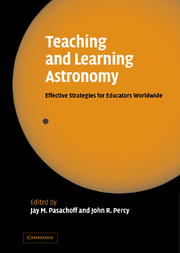Book contents
- Frontmatter
- Contents
- List of illustrations
- Preface
- Introduction
- Part I Astronomy in the curriculum around the world
- Part II Astronomy education research
- Part III Educating students
- Introduction
- 8 Textbooks for K–12 astronomy
- 9 Distance/Internet astronomy education
- Open discussion
- Poster highlights
- Part IV Educating teachers
- Part V Astronomy and pseudoscience
- Part VI Astronomy and culture
- Part VII Astronomy in developing countries
- Part VIII Public outreach in astronomy
- Part IX The education programs of the International Astronomical Union
- Part X Conclusions
- Author index
- Subject index
9 - Distance/Internet astronomy education
Published online by Cambridge University Press: 18 May 2010
- Frontmatter
- Contents
- List of illustrations
- Preface
- Introduction
- Part I Astronomy in the curriculum around the world
- Part II Astronomy education research
- Part III Educating students
- Introduction
- 8 Textbooks for K–12 astronomy
- 9 Distance/Internet astronomy education
- Open discussion
- Poster highlights
- Part IV Educating teachers
- Part V Astronomy and pseudoscience
- Part VI Astronomy and culture
- Part VII Astronomy in developing countries
- Part VIII Public outreach in astronomy
- Part IX The education programs of the International Astronomical Union
- Part X Conclusions
- Author index
- Subject index
Summary
Abstract: Since the early 1990s there has been a proliferation of astronomy courses offered over the Internet. Accompanying the courses has been an increasing number of robotic and remote-control telescopes. Since 1994, Charles Sturt University, Australia, has offered a course on cosmology for gifted and talented high-school students and, since 2000, a remote control telescope for use by elementary- and high-schoolteachers and their students. Both programs are accompanied by extensive resource materials and are offered by distance education to participants. This paper describes many of the outcomes of the research conducted on both projects and what has been learned with respect to the necessary conditions in order that elementary- and high-schoolteachers engage with exciting programs on offer. Professional development of teachers is a key issue if these programs are to be successful.
Introduction
There have been exciting times since the advent of the World Wide Web in Australia in 1993. The medium has led to a proliferation of courses on the Internet for people interested in a whole host of things ranging from astronomy to astrology, from cosmology to cosmetology, and from celestial mechanics to celestial creativity. Accompanying the courses has been a proliferation of controllable devices: the first robotic telescope was made available in 1993 at the University of Bradford; other projects have been “Telescopes in Education” in 1996, the Charles Sturt University (CSU) Remote Telescope Project in 2000, and the Faulkes Telescope Project in 2003. Other robotic devices in their various forms from cars to manipulators to electron microscopes are also available.
- Type
- Chapter
- Information
- Teaching and Learning AstronomyEffective Strategies for Educators Worldwide, pp. 104 - 116Publisher: Cambridge University PressPrint publication year: 2005

